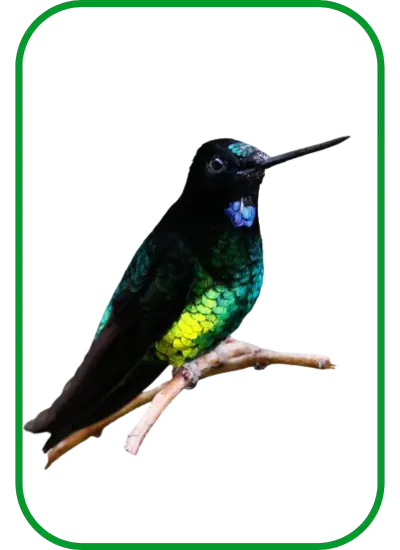Curious to know about Hummingbirds?
Here you can find details of the world’s tiniest bird, Hummingbird. Hummingbirds belong to a diverse group of small, often brightly colored birds and are found exclusively in the Western Hemisphere.
Hummingbirds continue to attract both bird fans and researchers due to their distinctive qualities and habits, ranging from their ability to hover in front of flowers to their specialized diet and territorial attitude.
The 366 species of hummingbirds within the Trochilidae family are acknowledged by the International Ornithological Committee (IOC), and they are classified into 113 genera. After Flycatchers, they are the world’s second-largest bird family.
Anatomy of a Hummingbird
With their unusual wing shape and powerful muscles, hummingbirds are the only birds that can hover, fly backward, or even upside down. Their small cup-shaped nests, distinct nesting practices, and nest content distinguish them from many other bird species.
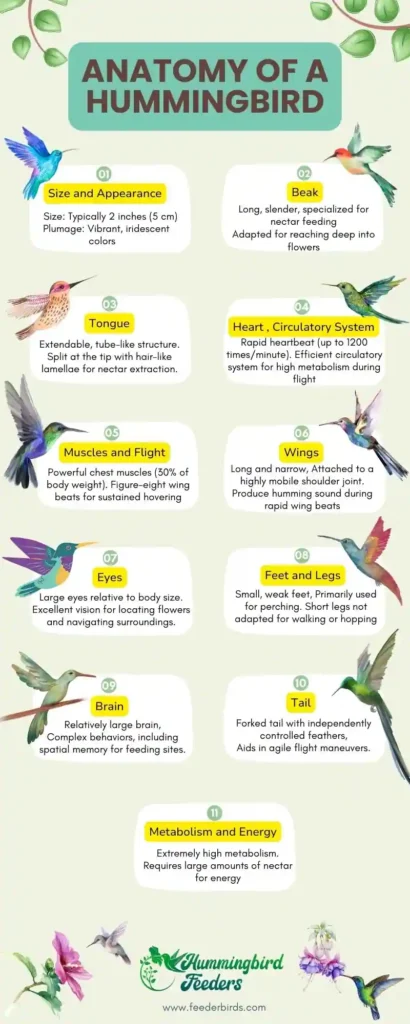
Hummingbirds with their diverse types in your yard may be both entertaining and perplexing. In some circumstances, it’s simple, but in others, recognizing the species can be a genuine challenge. This article will equip you to discover different hummingbird species.
Hummingbirds’ Species
Kick off the day with learning about Hummingbirds and get insight into their various species:
1. Ruby-Throated Hummingbird
The Ruby-throated Hummingbird is a common species in North America and it is a sole breeder in the Eastern North Areas. These little, lively birds can be found in gardens across Canada and the Eastern and Central United States.
The male Ruby Throated’s unique characteristic is a vibrant redneck patch. It not only looks enchanting but also a tactic for attracting mates. This bright burst of color has won them charming nicknames like Ruby or Ruby-throated. They are more attracted to feeders in yards and gardens.
Fortunately, they are least threatened by the study of International Union for Conservation of Nature Red List, suggesting a steady population and little chance of extinction. The Ruby-throated Hummingbird is a well-known figure in North American birding because of its agility and beauty.
The oldest Ruby-throated Hummingbird ever recorded was a female. She was at least 9 years and 2 months old when researchers caught and released her again in 2014 in West Virginia during their banding operations.

2. Anna’s Hummingbird
Anna’s Hummingbird is among the most common hummingbirds along the Pacific Coast. They look like flying jewels with their brilliant green feathers and glittering rose-pink necks.
Anna’s Hummingbirds make a big impression despite being no bigger than a ping-pong ball. Males ascend to 130 feet into the air and then swoop to the earth with a strange blast of sounds produced by their tail feathers in their spectacular courting rituals.
Anna’s Hummingbird’s dive show lasts around 12 seconds, and the male may soar up to 40 meters during the performance. It begins by hovering two to four meters in front of the object, then rises straight up in a zigzag way.
Bees and wasps may become stuck on the wing of Anna’s Hummingbird in rare instances, causing the bird to starve to death. Anna’s Hummingbirds often have a body temperature of approximately 107 degrees Fahrenheit, which is quite hot for a person.
The oldest known Anna’s Hummingbird was at least 8 years and 2 months old. It was caught and released during a banding operation in Arizona.
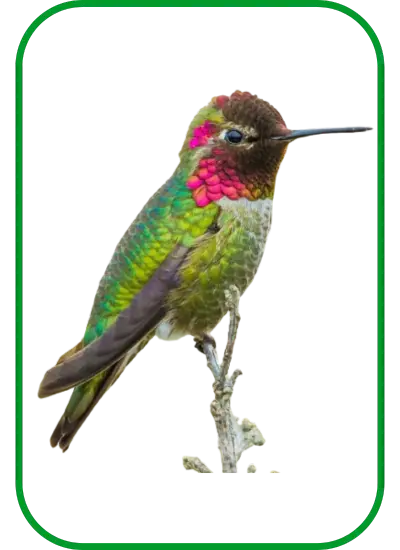
3. Black-Chinned Hummingbird
Black-chinned Hummingbirds are found all across the world, from deserts to mountain forests. This is a little green-backed Western hummingbird with no dazzling colors on its neck except a narrow strip of iridescent purple edging the black chin that is only visible when the sun hits it.
Their nests can be found every 100 meters or more along decent portions of various rivers in southern Arizona and southern New Mexico. The tongue of the Black-chinned Hummingbird contains two grooves through which nectar flows by capillary action before the bird retracts the tongue and squeezes the nectar into the mouth.
It licks the virtually closed bill at a rate of around 13-17 licks per second and consumes 0.61 milliliters (about one-fifth of a fluid ounce) in a single meal. At rest, the heart beats an average of 480 beats per minute. They go into torpor on cold days, and their heart rate lowers to 45-180 beats per minute.
The oldest Black-chinned Hummingbird ever recorded was a female. It was at least 11 years and 2 months old when scientists caught and released it in Texas during a banding operation in 2008.

4. Rufous Hummingbird
The Rufous Hummingbird is beautiful. The male’s iridescent neck flashes brighter than a shining copper penny, and he whizzes through the air, hovering directly in front of those who observe them. They are one of the tiniest hummingbirds, a little over 3 inches long, but one of the most strong hummingbirds.
They breed in Northwestern U.S. and Canadian forests. They travel 3,900 miles in one way from Alaska, where they spend the summer, to Mexico, making it one of the world’s most extended migratory treks for a bird of its size. Rufous Hummingbirds are gifted with quick, darting flight and precision agility.
They are aggressive birds that relentlessly chase away other hummingbirds, even when they are simply passing by. The Rufous Hummingbird has a strong spatial memory, which very likely aids it in finding flowers from day to day or year.
The oldest Rufous Hummingbird ever recorded was a female. She was at least 8 years and 11 months old. It was caught and released in British Columbia during a banding operation in 2004.
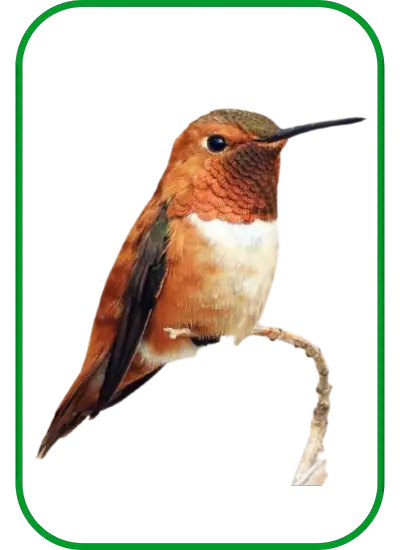
5. Calliope Hummingbird
This is North America’s tiniest bird, measuring approximately 3 inches long and weighing about a tenth of an ounce. Despite its small size, it can survive in the chilly summer nights at high elevations in the northern Rockies, and migrate from Canada to southern Mexico every year. The magenta rays on the male’s neck are the most distinguishing characteristic of a Calliope Hummingbird.
Males and females are both greenish above, but males have a greenish vest underneath, and females and immatures have a peachy splash over their underparts. Each year, Calliope Hummingbirds migrate around 5,000 miles in a large oval from breeding to wintering sites.
Male Calliopes are courageous and possessive enough during the breeding season to chase away much larger birds, even hawks, from their area.
When a female Calliope Hummingbird was recovered and released during banding operations in Idaho in 2014, she was 8 years and 1 month old.

6. Broad-Tailed Hummingbird
The broad-tailed hummingbird is a medium-sized hummingbird species that lives in open mountain areas in Western North America, from the United States and Canada to Mexico and Guatemala. At first sight, the male’s body appears completely dark, yet in the correct light, it looks like brilliant blues and greens.
Females are duller in color than males, with a noticeable white stripe behind their eyes. They have broad tails that zip from blossom to flower, hovering over flowers to gather nectar. Females create a loud, metallic-sounding flutter with their wings.
They breed in various woodlands up to 3,230 m, and they winter in diverse forests and urban areas. Males also engage in aerial displays, soaring far into the sky and swiftly falling to the ground, emitting a harsh metallic trill with their wings.
Broad-tailed Hummingbirds are widespread, although their populations are declining at a rate of more than 1% per year. It is on the Yellow Watch List, which includes birds that are most in danger of extinction in the absence of solid conservation initiatives to reverse losses and alleviate threats.
The oldest Broad-tailed Hummingbird ever recorded was a female. She was more than 12 years and 2 months old when scientists caught and released her during a tagging project in Colorado in 1987.
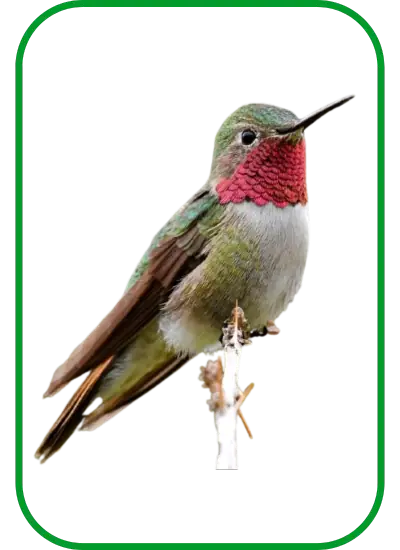
7. Costa’s Hummingbird
Costa’s hummingbird is a species of hummingbird in the Trochilidae family. It breeds in the dry Southwest United States and Northwest Mexico, and it spends the winter in Western Mexico. This species nests in the Arizona and California deserts in late winter and early spring, and most migrate to coastal California and Baja to avoid the harsh summer.
Costa’s Hummingbirds are standard, with populations that are either constant or slightly diminishing. Costa’s Hummingbirds hover over flowers to drink nectar and catch tiny flying insects. During the mating season, males defend territory around prominent perches and nectar supplies. They sing a high-pitched whistle when diving.
They loop around and execute dives for the female without pausing, sometimes for up to 4 minutes, but the performance typically lasts approximately 35 seconds. If that wasn’t enough to catch the female’s eye, they additionally hover precisely in front of her, their gorget flared.
The oldest Costa’s Hummingbird on record was a female. She was at least 8 years and 9 months old when researchers caught and released her during banding operations in California in 2009. Interestingly, she was initially banded in the same state back in 2001.

8. Allen’s Hummingbird
Allen’s hummingbird is a small bird, with mature adults measuring 3 to 3.5 in (76 to 89 mm) in length and weighing between 2 to 4 grams. The male has a green back and forehead, with rufous flanks, rump, and tail. Females are predominantly green, with rufous coloration on the tail and white tips.
The male has a shimmering orange-red throat. During the mating season, male and female Allen’s Hummingbirds occupy separate habitats. In comparison to most North American birds, the Allen’s Hummingbird migrates exceptionally early.
Northbound birds can leave their wintering habitats as early as December and arrive on their breeding grounds as early as January when the winter rains bring an abundance of blooms.
When an Allen’s hummingbird was captured and rereleased in California during banding operations in 2009, the oldest captured Allen’s Hummingbird was at least 5 years 11 months old.

9. Buff-Bellied Hummingbird
The Buff-bellied Hummingbird can be distinguished from other hummingbirds in the United States by its warming buff belly, dazzling red beak, and, in the correct light, beautiful blue-green neck and breast.
This hummingbird hardly crosses the border between the United States and Mexico, and it consumes nectar from flowers in residential gardens, mesquite brushlands, and river corridors in South Texas.
Belize, Guatemala, Mexico, and the United States are all home to this species. Adult males have a rose crimson bill with a dusky tip; females have a darker maxilla.
The oldest Buff-bellied Hummingbird ever recorded was a male. He was at least 11 years and 2 months old when scientists recaptured and released him during banding operations in Texas.
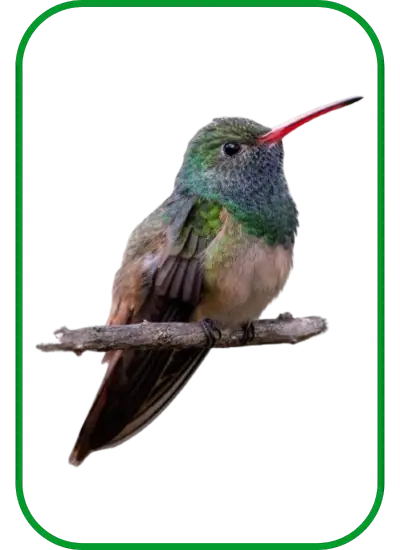
10. Blue-Throated Mountain Gem
The Blue-throated Mountain Gem is a giant hummingbird species that lives in the United States. It is well-known for its commanding presence around bird feeders and flower areas. Males and females are both gray below, with a dusky-greenish back, a brown rump, and a long black tail with distinct white edges.
The male has a vivid blue neck patch that is difficult to detect unless the sun is shining directly on it. This species is more significant than a Bridled Titmouse but smaller than a Broad-tailed Hummingbird. It may be found as far south as Oaxaca in Mexico’s Sierra Madre Oriental and central plateau.
The Blue-throated Mountain-gem flaps the wings roughly half as rapidly as lesser species, as one might expect from the giant hummingbird species in the United States. Despite this, it gets to outperform them 23 times per second when hovering.
When a male Blue-throated mountain gem was recovered and rereleased during banding operations in Arizona, it was at least 7 years and 11 months old.

11. Broad-Billed Hummingbird
The broad-billed hummingbird is a tiny hummingbird found in Mexico and the southwestern US. Every day, a Broad-billed Hummingbird eats 1.6 to 1.7 times its body weight in nectar. In his courtship display, the male Broad-billed Hummingbird hovers about a foot from the female and then flies back and forth in repeated arcs, much like a pendulum.
The male Broad-billed Hummingbird has a dark green body with white undertail-coverts and a blue throat. Its tail is broad and blackish-blue, while the flight feathers are brownish-gray. The adult female, on the other hand, has a pale belly with a white eyestripe behind her eye, and her tail feathers are white-tipped. The male’s bill is shorter but brightly red in color.
The oldest recorded Broad-billed Hummingbird was a male, and he was at least 9 years and 1 month old when he was recaptured and released during banding operations in Arizona.

12. Violet-Crowned Hummingbird
This hummingbird is distinguished by its iridescent bluish-violet head, red beak, and gleaming white underparts. It is the only species of American hummingbird without a highly colored gorget (throat patch).
Violet-Crowned Hummingbird hovers at flowers and inserts the bill into the bill to suck nectar with the tongue. In addition, it collects insects from plants and catches flying insects. Bronzy green on top and pure white on the bottom, with no glittering gorget.
The crown is purple-blue iridescent, with a little white patch below the eye. The violet-crowned hummingbird is generally migratory in the United States and into Sonora and Chihuahua, although some individuals have overwintered as far north as Arizona.
The oldest recorded Violet-crowned Hummingbird was at least 6 years and 1 month old when it was recaptured and released during banding operations in Arizona.
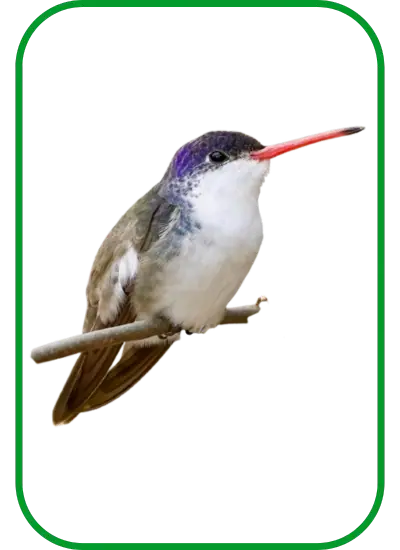
13. Rivoli’s Hummingbird
The Rivoli’s Hummingbird is the most fascinating regular hummingbird in Southeast Arizona. It’s not very frequent, but it may be found in a variety of locations throughout our Sky Island mountain ranges, so you have a decent chance of viewing one. They are found in Central American montane forests (Mexico, Guatemala, Honduras)
Rivoli’s hummingbird is the second biggest in the United States. Ornithologists renamed Rivoli’s hummingbird “Magnificent Hummingbird” in 1983. However, when Magnificent was divided into two species in 2017, the name Rivoli’s was reinstated for the species found between the United States and Nicaragua.
The second species was named “The Talamanca Hummingbird” because it had a blue gorget rather than Rivoli’s purple gorget. Rivoli’s Hummingbirds have one of the most incredible heart rates reported in any vertebrate, ranging from 420 to 1,200 beats per minute.
When a male Rivoli’s Hummingbird was recovered and re-released during banding operations in Arizona, he was at least 11 years and 2 months old.

14. Lucifer Sheartail
If you want to enjoy with the beauty of hummingbirds, the summer rain season is the best time to visit Southeast Arizona since variety is at its highest. The Lucifer Hummingbird, a rare migratory species from Mexico, is a sought-after bird whose range is limited to the United States and Texas.
The Lucifer sheartail, also known as the Lucifer hummingbird, is a medium-sized, 10 cm long green hummingbird with a slightly bent beak and gorget feathers that flare outward. The small, brightly purple-throated Lucifer Hummingbird is primarily found in northern and central Mexico.
It is a highly sought-after species among ardent birders when it arrives in the United States, in extreme southern Arizona, New Mexico, and west Texas.
The oldest known Lucifer Hummingbird was a male, and he was at least 7 years and 5 months old when researchers recaptured and released him during banding operations in Texas.
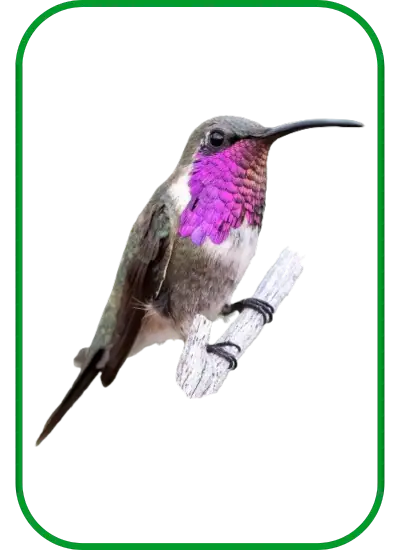
15. Berylline Hummingbird
The Berylline hummingbird, which is common in Mexico’s uplands, first emerged in the United States in 1964. It has become practically a regular visitor since then, with one or two seen almost every summer in the highlands of southeastern Arizona; it has nested there a few times.
Because of the color likeness, the Berylline Hummingbird is named after the gem beryl. Males of all subspecies have a black maxilla and a pinkish mandible with a black outer half on their bills. The berylline hummingbird’s movements vary according to location.
Except in the far north, where it migrates south for the winter, it is sedentary throughout much of its range. It has become more common in southern Arizona, where it has strayed and occasionally bred, as well as in southwestern New Mexico and western Texas. Even over the majority of its range, it appears to undergo seasonal elevation fluctuations.

16. White-Eared Hummingbird
The White-eared Hummingbird is a medium-sized hummingbird found in highland pine-oak and pine-evergreen forests, as well as higher elevation clearings and borders of coniferous woods. These birds are territorial and spend most of their time in the lower and intermediate levels of the forest, frequently along low flower banks.
They mainly eat on nectar and insects, reaching deep inside blooms with their long bills or catching small insects in mid-air. Both sexes wear a black mask with a prominent and broad white ear stripe and a red bill base.
Females have a light neck and breast with green patches, while males have a violet and greenish-black head and throat. The female White-eared hummingbird incubates two eggs for 14 to 16 days before fledging, which takes 23 to 28 days.
A season may see the species raise two broods. The IUCN lists the White-eared Hummingbird as the Least Concern; however, its population is susceptible to mountain forest removal. They are unusual visitors in the United States, but they can be observed at feeders in mountain valleys, particularly in places dominated by oak, pine, or Douglas-fir.

17. Mexican Violetear
The Mexican Violetear is a medium-sized, metallic green hummingbird that may be found from Mexico to Nicaragua. The Mexican Violetear is a dark emerald green bird with a purple ear patch and a dark blue tail with a thick black band.
The species is endemic to the American tropics’ highlands, from Mexico to Nicaragua, and has been found in Texas and other isolated regions from coast to coast and as far north as Canada. Mexican Violetears are solitary hummingbirds that enjoy damp high altitudes.
They are known to roam far, with specimens being spotted as far north as Wisconsin on occasion. Mexican Violetears are relatively uncommon in Texas. However, they are not found in South Dakota. They have been observed breeding in the highlands south of Nicaragua and southern Mexico.

18. Green-Breasted Mango
The Green-breasted Mango is a giant hummingbird found in the American tropics’ tropical lowlands and forest borders, stretching as far north as northern Mexico. It is a giant hummingbird with a black beak that is slightly arched and prefers forest borders and open places with scattered tall trees.
The male is substantially dark, deep green all over, with a black neck and purple tail, but the female and young have a broad dark stripe along the middle of the throat and breast, as well as white tail corners. The female constructs a cup nest of soft plant fibers with tree bark and lichens on the exterior and spider silk holding it all together.

19. Bee Hummingbird
The Bee Hummingbird is the smallest hummingbird. This hummingbird is 2.25 inches long, and it weighs approximately 2.6 grams. These species can only be found in Cuba. The male Bee Hummingbird is distinguished by its iridescent plumage and fiery red throat, but the female Bee Hummingbird is characterized by a more subtle green and white appearance.
These birds impress with midair hovering and backward flight. Their fast metabolism leads to heart rates reaching 1,200 beats per minute. The Bee Hummingbird consumes nectar from flowers and small insects to get proteins. In their native environment, they also play an important role as pollinators for a wide variety of plant species.

20. Xantus’s Hummingbird
The Xantus hummingbird is a medium-sized hummingbird found on Mexico’s Baja California peninsula. It recalls Hungarian naturalist John Xantus de Vesey. Males have emerald green upperparts, black masks, prominent white ear stripes, red beak bases, and beautiful rusty tails.
Females have light cinnamon underparts. The Xantus hummingbird eats nectar from flowering plants, shrubs, and trees at all vegetation levels. Small flying and foliage insects are also its diet. It protects the feeding area and pollinates madrone, a popular nectar source.
The species breeds in the north between July and September or October. The nest is a cup made of fine plant fibers, other plant materials, and small feathers that are tied with spiderwebs and embellished with lichen and bark. It usually hangs from a thin branch 1–2 meters above ground. The Baja California-specific Xantus hummingbird has a small range.
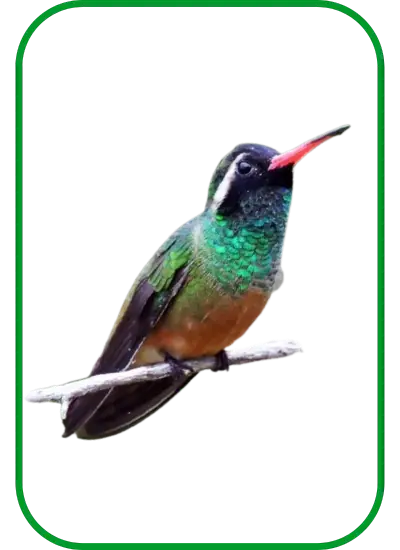
21. Cinnamon Hummingbird
The Cinnamon Hummingbird is a medium-sized hummingbird found from northeastern Mexico to Costa Rica, with a range that extends from sea level to approximately 1,600 meters (5,200 feet). The cinnamon-colored body and bronze-green upperparts distinguish the species.
The Cinnamon Hummingbirds are territorial, defending their feeding grounds from other hummingbirds, wasps, and butterflies. The breeding season varies across their area, although nesting occurs all year. Their nests are cups formed of plant material and spider webs that are set horizontally on a branch.
Typically, the clutch size is two eggs. With a vast range and an estimated population of at least 500,000 adult individuals, the International Union for Conservation of Nature (IUCN) has classified the Cinnamon Hummingbird as Least Concern.

22. Plain-Capped Starthroat
The Plain-capped Starthroat, a large hummingbird native to Mexico, Central America, and the southwestern United States, particularly Arizona, boasts distinct characteristics. These include a lengthy and straight bill, a face adorned with stripes, and a male featuring a red gorget, imparting a melancholic appearance.
This species not only inhabits a variety of environments, including dry woods, thorn forests, scrublands, and open areas with scattered trees, but it also maintains a year-round presence in many of these locales. Its sustenance comes from actively feeding on nectar derived from a diverse array of flowers as well as small animals.

23. Bumblebee Hummingbird
The bumblebee hummingbird is a hummingbird species found in Mexico’s highlands. It is one of the world’s tiniest birds, measuring less than 6cm long and weighing only a few grams. The male has a magenta-pink gorget, while the female has a dark-spotted neck and the same tail pattern as the male.
The bee hummingbird, scientifically known as Mellisuga helenae, is found only in Cuba and the nearby Isla de la Juventud. The bumblebee hummingbird relies on nectar and tiny arthropods, and although more giant hummingbirds control it, its modest size allows it to forage in their territory without conflict.
The species achieves reproductive conditions between April and July; however, records show that they typically breed during the winter. Their nests are mostly made of mosses and lichens, as well as reddish hair and other hairy seeds like bromeliad Catopsis seeds.
The bumblebee hummingbird is found along the Pacific and Atlantic ridges, as well as throughout the country’s core along the Transvolcanic strip to Oaxaca.

24. Amethyst-Throated Mountain gem
The Amethyst-throated Mountaingem is a hummingbird that lives in El Salvador, Guatemala, Honduras, and Mexico. This species is generally found in mountainous wet evergreen and pine-oak woods, where it feeds on nectar from a variety of blooming flowers or plants and also eats some insects.
The gorget of the male hummingbird is violet to royal blue, and this hummingbird performs aerial displays to attract females in the mornings and nights. The female constructs the nest, which is a bottomless cup of plant fibers connected with spider silk and moss.
The Amethyst-throated Mountain gem is a fascinating and attractive bird that contributes to the rich biodiversity of the areas in which it lives.
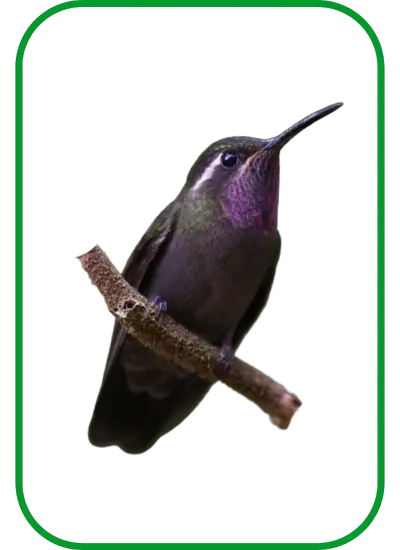
25. Bahama Woodstar
The Bahama Woodstar is a medium-sized hummingbird found across the Bahamas. It has a slightly curved bill. The plumage is green on top and olive-buff on the underparts. During breeding season, the male has a reddish-pink neck with a white collar.
After the mating season, he loses his colorful neck, which turns into a pale grey tint. The female’s plumage is substantially duller. The Bahama Woodstar is one of the Bahamas’ only three native birds. It is most frequently spotted at hummingbird feeders.
In its native region, the bird will breed at any time of year, with evidence suggesting nesting happens most frequently following times of heavy rain, which results in a rush of blooming plants.
The female Bahama Woodstar is in charge of constructing the cup-shaped nest of plant fibers from a shrub or tree. The Bahama Woodstar is a rare bird that should be seen if you visit the Bahamas.
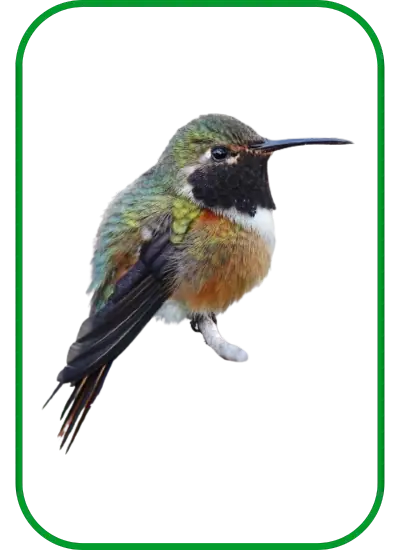
26. Long-Billed Hermit
The long-billed hermit is a big hummingbird in the Trochilidae family, distinguished by its long, decurved beak and greenish-brown upperparts with brownish to grayish underparts. The beak of the bird is long and down-curved, with the females’ being shorter but more curved than the males’.
It has dark and light ochre streaks on its upper tail coverts, and its center tail feathers are long with white tips. The mating seasons vary significantly across its range, ranging from April to July in Mexico, May to September in Panama, and January to April or May in Colombia.
The nest is a cone-shaped cup dangling from the underside of a tree constructed of plant fibers and spider silk. Typically, the clutch size is two eggs. These intriguing birds are supposed to roam short distances and do not undertake large-scale migrations.

27. Ecuadorian Hillstar
The Ecuadorian Hillstar, commonly known as the Chimborazo Hillstar, is a hummingbird endemic to Ecuador and southern Colombia’s Andes. It lives in high-altitude alpine grassland habitats between 3500 and 5200 meters in elevation.
The male has a vivid violet-purple head, but the female has a more muted coloring. Ecuadorian Hillstars are aggressive and frequently monitor from atop a bush. During conflicts between males protecting their feeding zone, they are reported to produce violent chattering.
The female is in charge of constructing the nest, incubating the eggs, and feeding the young. She shoves food down the chicks’ throats and into their tummies with her robust bill. Despite its tiny distribution, the Ecuadorian Hillstar contains two subspecies that have piqued the interest of numerous scientists, including Alfred Russel Wallace.

28. Green-Crowned Brilliant
The Green-crowned Brilliant is a giant hummingbird with a sleek, long tail and a straight beak. Males are entirely emerald green with a little blue throat patch, while females have a speckled green breast with a prominent white mustache stripe and a white spot behind the eye.
These birds may be found in a variety of environments, such as wooded regions, the borders and clearings of humid sub-montane and montane forests, mature secondary forests, and gardens. They eat nectar from a range of strongly scented tiny flowers, preferring those with the maximum sugar concentration.
Males have bronze-green plumage with a green crown, forehead, neck, and breast. They also feature a white mark behind the eye, a little violet neck patch, white thighs, and a blue-black tail with deep forks. Females have green-spotted underwing plumage, a white patch behind the eye, and a white line below the eye.
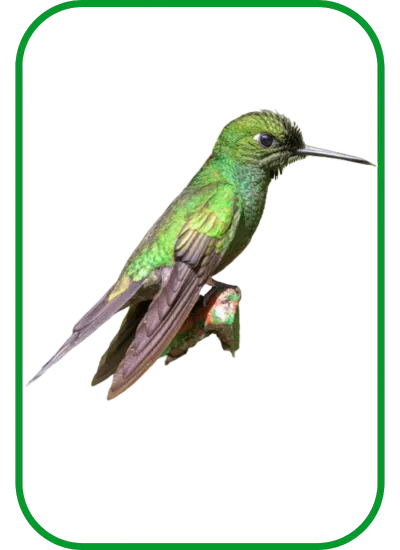
29. White-tipped Sicklebill
The White-tipped Sicklebill is found in the understory of humid forests in foothills and on mountain slopes from Costa Rica south to northern Peru. It is well-known for its distinctive traits and actions. The bird’s main distinguishing characteristic is its sharply decurved beak, which distinguishes it from other hummingbirds.
It is divided into three subspecies, each with its own distribution. The White-tipped Sicklebill is a woodland bird that feeds on nectar from flowers, mainly Heliconia and Centropogon.
It has also been observed stealing insects off tree trunks and branches, as well as spider webs. The bird’s unusual mannerisms, such as eating on bent petals and hanging upside down, make it an enthralling topic for bird watchers and nature lovers.

30. Black Jacobin
The Black Jacobin Hummingbird is a stunning bird found in the Atlantic Rainforest of Brazil’s central and tall secondary forests. The male of this species has primarily black feathers and a unique long, forked tail, while the female has a more bronze-green hue.
The Black Jacobin is a medium-sized hummingbird that is around 4 inches tall. This bird is a nectarivore that feeds on the nectar of many flowering plants, and it is an essential pollinator in its ecology. For protein, it also swallows tiny insects and spiders.
The Black Jacobin is notable for its swift flying and ability to eat while hovering in front of flowers. Unfortunately, the Black Jacobin, like many other species in the Atlantic Rainforest, is threatened by habitat loss and fragmentation.

31. Purple Throated Woodstar
The Purple-throated Woodstar is a stunning and tiny hummingbird found in South America’s Andes. Males of this species have iridescent plumage and a dazzling purple neck, which gives them their name. They are well-known for their incredible agility and may frequently be spotted dashing between flowers in quest of nectar.
Females, on the other hand, seem more subdued, with green and white feathers.These birds are most commonly found in montane and cloud forests, where they feed on the nectar of various blooming plants. They also feed on tiny insects and spiders for protein.
Purple-throated Woodstars are distinguished by their unusual high-pitched vocalizations, which they utilize for communication and courting.The conservation status of the Purple-throated Woodstar is in jeopardy due to habitat loss and fragmentation. In the Andean area, efforts are being made to conserve its natural environment and safeguard these gorgeous birds.

32. Shining Sunbeam
This species is notable for its “shining” look, which is generated by small feathers on its body reflecting light and giving it the illusion of glowing. The bird also has a distinct “humming” sound, which is caused by its wing beats. The Helianthemus, or Shining Sunbeam Hummingbird, is a tiny but lively bird species notable for its iridescent plumage and distinct habits.
The body of the Shining Sunbeam is predominantly greenish-black, with a blue-black tail and a tinge of red in the tail feathers. It has long, pointed wings and a white throat.
Males have black throats and backs, while females have brownish-grey backs and throats. The Shining Sunbeam Hummingbird may be found throughout North America, from Minnesota to Florida and as far west as Texas and California.
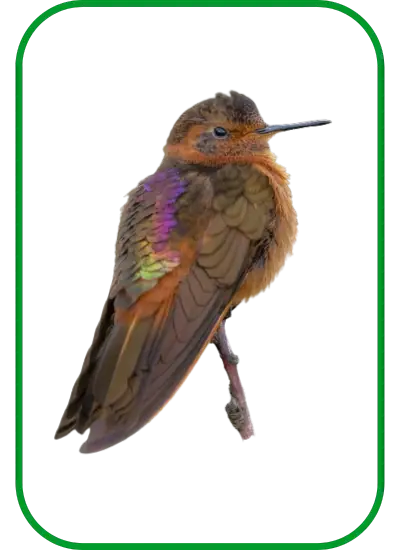
33. Purple-Throated Carib
The Purple-throated Carib is a hummingbird species found in the Caribbean. It is distinguished by its stunning appearance, with the male sporting iridescent green plumage and, as the name implies, a brilliant purple neck. In contrast, the female has green upperparts and a white-tipped tail. With their long, specialized beaks, these birds mostly eat on nectar from different flowers, but they occasionally grab insects in flight for protein.
The Purple-throated Carib prefers montane woods, gardens, and coastal scrublands. They are famous for their acrobatic flying and peculiar humming sound produced by the fast flapping of their wings. These birds serve an essential role in pollination and are an important element of the ecosystems in which they live.

34. Black Metaltail
The Black Metaltail is a hummingbird found in South America’s Andes, namely in Bolivia, Peru, Ecuador, and Colombia. The male of this stunning bird has a larger, highly forked tail and iridescent, metallic green and black plumage.
It lives in montane and cloud forests, frequently in the understory and on the borders of these environments. The Black Metaltail mainly feeds on nectar from various flowers, which it obtains using its unique beak and long, extendible tongue. It also feeds on tiny insects and spiders for protein.
These birds are distinguished by their unusual vocalizations, which include piercing, high-pitched cries and trills. The Black Metaltail pollinates numerous plant species in its environment, making it a crucial contribution to the ecological health of Andean ecosystems.

35. Green-Backed Firecrown
The Green-backed Firecrown is a hummingbird species found in Argentina and Chile, with isolated occurrences in the Falkland Islands. It lives in a range of habitats, including forest margins, plantations, clearings, and thickets, and is very prevalent in certain areas, including Robinson Crusoe Island and the Chilean matorral ecoregion.
Adult males of this species have an iridescent red-yellow crown, which gives rise to its name. It is the sole hummingbird in most of southernmost South America and is notable for its territorial nature, frequently chasing larger birds such as caracaras.
The Green-backed Firecrown eats tiny insects caught in flight and feeds on nectar from a range of native and imported flowering plants, preferring those of the genera Abutilon, Embothrium, and Fuchsia.
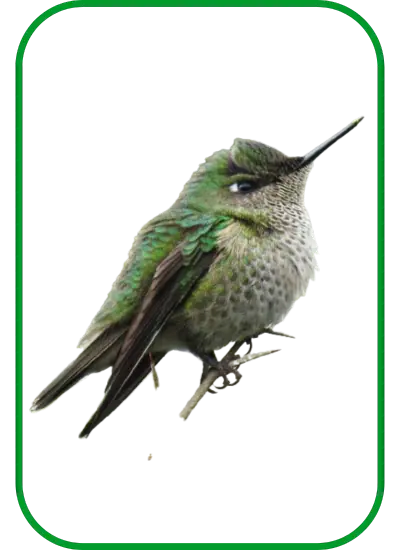
36. Violet-Tailed Sylph
The Violet-tailed Sylph Hummingbird is a tiny, iridescent hummingbird native to Southeast Asia. Their violet-colored tails and nectar-feeding behaviors distinguish them. Violet-tailed Sylph Hummingbirds are cavity nesters, which means they construct their nests in tree cavities rather than building their own.
They are recognized for their hovering and nectar-feeding behaviors, as do other hummingbirds. Females have a greenish-black neck and back, while males have a violet neck and back. Their tails possess a distinctive violet tint.
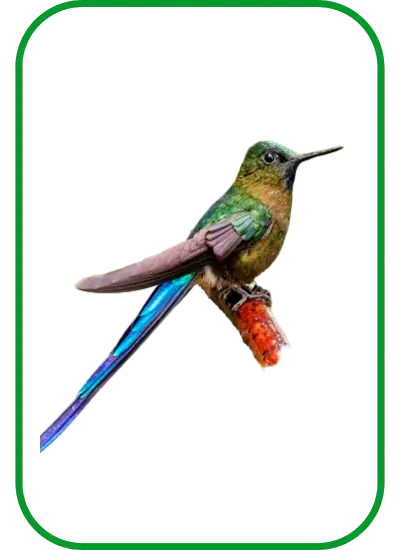
37. Fiery-Tailed Awlbill
The Fiery-tailed Awlbill is a hummingbird found in South America’s Andes. Its iridescent green plumage distinguishes it and, as the name implies, a flaming red tail. This little bird, around 9-10 cm long, is a master of mobility, capable of hovering in mid-air and flying in any direction with accuracy.
The Fiery-tailed Awlbill spends much of its time in montane and cloud forests, where it feeds on the nectar of various blooming plants. It, like other hummingbirds, is essential in pollination because its long, narrow beak helps it to reach deep into blooms for nectar.
For protein, it consumes tiny insects and spiders in addition to nectar. This species is not officially considered globally endangered, although it is threatened by hummingbird habitat loss and the effects of climate change.
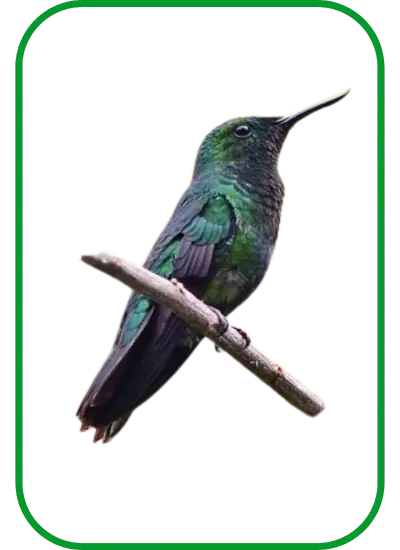
38. White-Bellied Hummingbird
The White-bellied Hummingbird is a medium-sized hummingbird that lives in the Andes, from northern Peru to Bolivia and northwestern Argentina. It may also be found in the lowlands of Bolivia and Brazil.
The upperparts of this species are golden-green, with white underparts and green dots on the side of the breast.The white-bellied hummingbird is commonly found along forest borders, woodland, scrub, and gardens, and it is reasonably widespread across its habitat.
Males flash their iridescent gorgets to entice females during courting flights, and their song is a quick burst of high-pitched squeaky sounds. The species are not migrating hummingbirds and does not migrate seasonally, remaining in its natural areas all year.

39. Rufous-Tailed Hummingbird
The Rufous-tailed Hummingbird is a medium-sized hummingbird with a rufous-colored tail, thus its name. It is found in wet tropical lowlands, where it prefers forest borders, second growth, and gardens. Except for a chestnut-brown tail, the mature male has a green head and upperparts.
Green on the throat, upper breast, and sides, gray on the lower breast, white on the belly, and chestnut-brown on the undertail coverts. At feeding places, these birds are aggressive and territorial, frequently chasing away other hummingbirds and giant insects.
They may be found in both natural and man-made settings, including agricultural, suburban, and urban locations. The Rufous Hummingbird has one of the world’s longest migratory flights, covering about 3,900 miles (one way) from Alaska to Mexico.

40. White-Necked Jacobin
The White-necked Jacobin is a beautiful hummingbird that lives in Central and South America. This bird is distinguished by its bright white neck and underparts, iridescent green upperparts, and long, straight black beak. With its iridescent blue head and throat, the male White-necked Jacobin stands out.
These birds prefer damp lowland woods in the tropics and subtropics, although they may also be found in surrounding woodland areas and gardens. White-necked Jacobins are significant pollinators in their environments because they feed on the nectar of many flowering plants.
They also collect flying insects to enhance their nutrition. To attract a female, the male performs aerial acrobatics during courting displays. The female is in charge of constructing the cup-shaped nest and nurturing the young.

41. Beautiful Sheartail
The beautiful sheartail, also known as the beautiful hummingbird, is a species of hummingbird that is endemic to Mexico. It is a little bird that is 7.7 to 9 cm in length and weighs 2.2 to 3g. The male has metallic golden green upperparts, a white line above the eye, and a metallic magenta purple gorget that becomes more violet and blue towards the back.
The female has metallic golden green upperparts that are duller on the crown, and its underparts are light grayish buff with cinnamon buff flanks. At elevations ranging from 1,000 to 2,200 m, the lovely sheartail lives in dry and semiarid scrublands, semi-open habitats with trees and shrubs, and gallery forests. It is a year-round inhabitant; however, after mating, some individuals move to near sea level in Oaxaca.

42. Giant Hummingbird
The giant hummingbird is the most prominent member of the hummingbird family, weighing 18-24 g and having a wingspan that’s roughly 21.5 cm and a length of 23 cm. Patagonia is the only species in the genus. The giant hummingbird usually appears alone, in pairs, or in small family groups.
These birds are exceptionally agile and acrobatic fliers, frequently involved in continuous hovering flight, which is often used not just to eat on their wings but also to defend their territory and court partners. The giant hummingbird flies at an appropriate rate for a hummingbird, 15 wing beats per second on average. Its heart rate at rest is 300 beats per minute.
The giant hummingbird occasionally glides in flight, which is unusual for hummingbirds. Its extended wings help it to travel more efficiently than other hummingbirds. The enormous hummingbird has a particularly loud, piercing, and whistling “chip” voice.

43. White-Booted Racket-Tail
The White-booted racket-tail is a hummingbird found in South American cloud forests. The male white-booted racket-tail has a long, blue tail and distinguishing white leg puffs, but the female lacks both the long tail and the leg puffs.
These birds are notable for their distinct foraging habit, which includes feasting on nectar from a range of plants such as Palicourea, Clusia, Inga, and Cavendishia, as well as hawking tiny insects from a perch. Their vocalizations are particularly different, with both males and females emitting various trills and notes.
The white-booted racket-tail prefers the borders of damp to wet woods and may be found at elevations ranging from 1,600 to 2,200 m. These birds are significant pollinators in the environment and contribute to the richness of their habitat.

44. Spot-Throated Hummingbird
The Spot-throated Hummingbird is a tiny South American bird endemic to the Andes Mountains, located in northern Peru and extreme southern Ecuador. It lives in dry to semi-humid woodland and scrub. The bird is 3-4 inches long with dull green upperparts, light gray underparts, green dots on the neck, and a white mark below the eye.
The most noticeable aspect of this species is the prominent white patch on its throat, which contrasts with the general green plumage on the head, back, and wings. Because the metabolism of the spot-throated hummingbird is so high, it must feed practically continually throughout the day to survive, visiting hundreds or even thousands of flowers.
The spot-throated hummingbird’s mating behaviors are exciting but not entirely known. To impress females, males undertake complex courting displays, soaring in loops and arcs. During the winter dry season, the bird migrates downslope to warmer climes with more abundant food, as far north as Colombia and Venezuela, and then returns upslope with the arrival of spring.

45. Glittering-Bellied Emerald
The glittering-bellied emerald hummingbird is an eye-catching and vivid bird native to Central and South America. This species is distinguished by its iridescent green plumage, which creates a brilliant look when it flies over the forest canopy.
The male has a dazzling, glittering turquoise or green throat and belly, thus its name. These little birds are around 9-10 cm long and are fascinating to see because of their quick flying and colorful feathers.The glittering-bellied emerald hummingbird is found in subtropical or tropical moist lowland forests, as well as badly degraded former forests.
It feeds primarily on nectar from various blooming plants, although it also eats tiny insects. This species is an important pollinator and an essential element of the ecology in its region.

46. Marvelous Spatuletail
The Marvelous spatuletail is a hummingbird species confined to Peru’s Andean cloud forests. It is distinguished by its long, spatula-shaped tail, which is covered with iridescent blue-green feathers. The male of the species likewise has a brilliant, iridescent green neck and a white breast, while the female has green and white feathers.
Because of habitat degradation and fragmentation, as well as the illicit pet trade, this species is considered endangered. Conservation efforts to safeguard the Marvelous spatuletail and its environment are underway, including the establishment of protected areas and the promotion of sustainable tourism.
The Marvelous spatuletail is a critical pollinator in its ecology, feeding on nectar from a wide range of blooming plants. It is also a famous bird among birdwatchers and environment enthusiasts, attracting tourists from all over the world to Peru’s cloud forests.

47. Chestnut-Bellied Hummingbird
The chestnut-bellied hummingbird, also known as the rufous-vented hummingbird, is a tiny, colorful bird with a chestnut-colored belly. These hummingbirds are endemic to Southeast Asia, with a few subspecies found in places such as the Himalayas, Pakistan, and Indonesia.
The back and tail of chestnut-bellied hummingbirds are brownish-grey, with a rufous (reddish-brown) belly and a darker grey face. Their wings are long and pointed, with square-cut tails. The acrobatic flying and foraging behaviors of chestnut-bellied hummingbirds are well-known.
They eat on the ground frequently, which is rare for hummingbirds. Chestnut-bellied hummingbirds are enthralling animals that captivate both birdwatchers and wildlife enthusiasts. These little birds are fascinating to see in their native habitat because of their peculiar look and behavior. The Chestnut-bellied hummingbird is a frugivore species and plays a vital role in seed dispersal and regeneration.

48. Violet-Throated Metal Tail
The Violet-Throated Metaltail is a rare hummingbird found only in Ecuador, particularly in the Western Cordillera of the Andes Mountains. This bird is special because it has a beautiful violet throat and is considered endangered due to its limited habitat, which covers an area of less than 2,000 square kilometers. Its habitat includes areas like Polylepis woodland, the upper edge of montane forests, and shrubby paramo.
Interestingly, this bird can tolerate some human presence in its habitat, as long as there’s enough native vegetation for cover. Researchers have discovered that the Violet-Throated Metaltail relies on certain flowers like Brachyotum, Berberis, and Barnadesia for its nectar, showing how important these plants are for its survival.
Despite its small size and limited habitat, this hummingbird plays a crucial role in its ecosystem by pollinating flowers and contributing to the biodiversity of its environment. Efforts to protect its habitat are vital to ensure the survival of this enchanting bird species for generations to come.
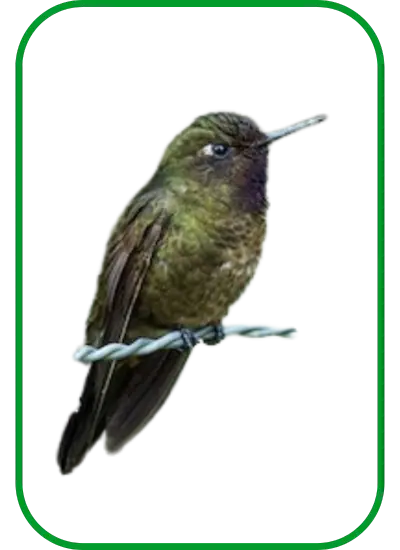
49. Hook-Billed Hermit
Hook-billed Hermit is a rare and endangered species of hummingbird in the Trochilidae family that is found only in a limited region in Brazil. The bird has a slightly curved beak, red underparts, a noticeable large white eyebrow, and a greenish tail with a white tip.
The face features a white supercilium and a “mustache,” while the tail is metallic golden with white-tipped outer feathers. These birds live in the understory of inland primary and coastal forests, primarily below 1,600 feet (500 meters) and around riverbanks.
The Hook-billed Hermit is assumed to live a sedentary or non-migration phase lifestyle. However, evidence from a few places makes this difficult to determine.
The mating season is thought to last from September to February, and the sexes have nearly identical plumage, with the female’s underparts being somewhat lighter. Only a few Hook-billed Hermits can be found in the southern Brazilian states of Bahia, Espirito Santo, and probably Minas Gerais and Rio de Janeiro.
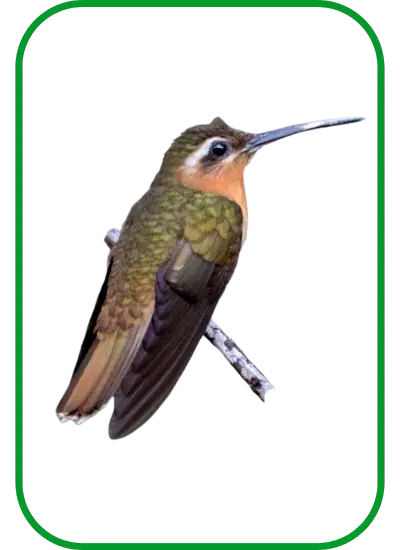
50. Santa Marta Sabrewing
The Santa Marta Sabrewing Hummingbird is a beautiful and uncommon bird found in Colombia’s Santa Marta Mountains. This lovely hummingbird is distinguished by its iridescent green and blue plumage, with a brilliant purple neck patch on the male. It is a huge hummingbird, averaging around 5 inches in length.
The species is restricted to the cloud forests of the Santa Marta Mountains, where it lives in the understory and on the forest borders. Birdwatchers and ornithologists flock to the area in the hopes of spotting this rare and lovely species. The Santa Marta Sabrewing Hummingbird is an emblem of the Santa Marta Mountains’ distinctive and endangered biodiversity.
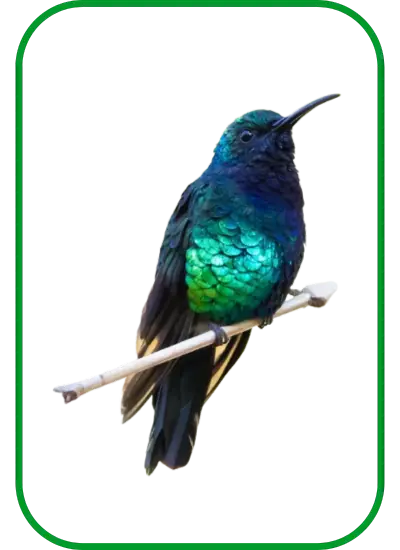
51. Oaxaca Hummingbird
The Oaxaca hummingbird, also known as the blue-capped hummingbird, is a medium-sized hummingbird found in Oaxaca, Mexico, in the foothills of the Sierra Madre del Sur. It is a unique and rare species that prefers wet, evergreen woods and shade-coffee plantations.
The Oaxaca hummingbird feeds mainly at low to intermediate elevations, darting between flowers and flashing its predominantly white tail wide. Its food has not been thoroughly characterized. However, it is known to feed on the blooms of Inga, Lobelia, Malvaviscus, and Psittacanthus, among other plants.
Like other hummingbirds, it is thought to feed on tiny arthropods. Little is known about the breeding habits of the Oaxaca hummingbird, however, active nests have been discovered in May, October, and November. The clutch size is two eggs.

52. Swallow-tailed hummingbird
The Swallow-Tailed Hummingbird is one of the most beautiful hummingbirds. It has highly brilliant colors that work well together to create an outstanding appearance. The Swallow-tailed Hummingbird is one of the biggest members of its family, reaching lengths of up to 6.5 inches. The tail accounts for over half of its whole length.
Its wings are around 3.15 inches in length. The Swallow-tailed Hummingbird spends most of its time in the dry, semi-open caatinga and cerrado environments of Brazil. The bird avoids damp habitats such as rainforests, however, it can be spotted in forest borders on occasion.
Following mating, the female Swallow-tailed Hummingbird constructs a cup-shaped nest lined with soft plant fibers and coated in lichen and mosses, which is kept together by sticky spider webs. She constructs the nest on a horizontal twig 10 to 15 feet above ground.
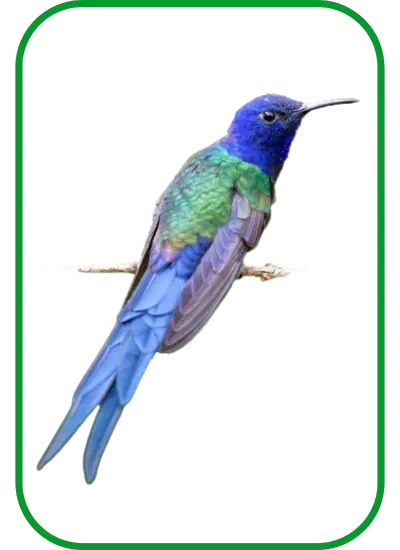
53. Dusky starfrontlet
The dusky starfrontlet is a tiny hummingbird found in South America’s Andes highlands. Despite its small size, the dusky starfrontlet has a remarkable set of adaptations that allow it to flourish in the harsh, high-altitude conditions in which it lives. It is also known as the sparkling starfrontlet, and it is an Endangered hummingbird species in the “brilliants” tribe Heliantheini subfamily Lesbiinae.
The male has a blue-green to golden-green sparkling forehead and a velvety black crown, face, and mantle. The back is green with black accents, the rump and upper tail coverts are a golden green iridescence, and the tail is a lighter green. The dark starfrontlet may be seen in just a few dozen locations in Colombia’s Western Andes.
